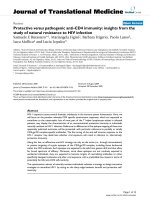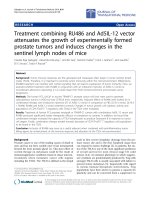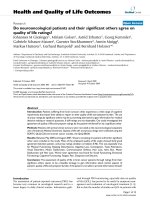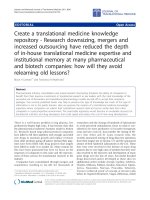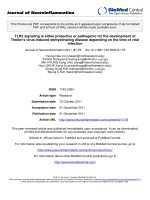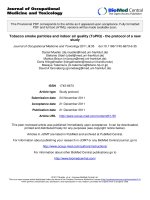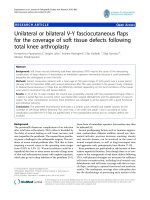Báo cáo toán học: " Acute myocardial infarction and coronary vasospasm associated with the ingestion of cayenne pepper pills in a 25-year-old male" pot
Bạn đang xem bản rút gọn của tài liệu. Xem và tải ngay bản đầy đủ của tài liệu tại đây (383.35 KB, 14 trang )
This Provisional PDF corresponds to the article as it appeared upon acceptance. Fully formatted
PDF and full text (HTML) versions will be made available soon.
Acute myocardial infarction and coronary vasospasm associated with the
ingestion of cayenne pepper pills in a 25-year-old male
International Journal of Emergency Medicine 2012, 5:5 doi:10.1186/1865-1380-5-5
Ozgur Sogut ()
Halil Kaya ()
Mehmet Tahir Gkdemir ()
Yusuf Sezen ()
ISSN 1865-1380
Article type Case report
Submission date 5 September 2011
Acceptance date 20 January 2012
Publication date 20 January 2012
Article URL />This peer-reviewed article was published immediately upon acceptance. It can be downloaded,
printed and distributed freely for any purposes (see copyright notice below).
Articles in International Journal of Emergency Medicine are listed in PubMed and archived at
PubMed Central.
For information about publishing your research in International Journal of Emergency Medicine go to
/>For information about other SpringerOpen publications go to
International Journal of
Emergency Medicine
© 2012 Sogut et al. ; licensee Springer.
This is an open access article distributed under the terms of the Creative Commons Attribution License ( />which permits unrestricted use, distribution, and reproduction in any medium, provided the original work is properly cited.
1
Acute myocardial infarction and coronary vasospasm associated with
the ingestion of cayenne pepper pills in a 25-year-old male
Ozgur Sogut*
1
, Halil Kaya
1
, Mehmet Tahir Gokdemir
1
, Yusuf Sezen
2
1
Department of Emergency Medicine, Harran University, Sanliurfa, Turkey.
2
Department of Cardiology, Harran University, Sanliurfa, Turkey.
*Corresponding author:
Email addresses:
OS:
HK:
MTG:
YS:
Abstract
Capsaicin, one of the major active components of cayenne pepper pills, is an over-the-
counter substance with sympathomimetic activity used commonly by young individuals
for weight loss. Here we report the case of a previously healthy young male who
developed severe chest pain after using cayenne pepper pills for slimming and sustained
2
an extensive inferior myocardial infarction. Electrocardiography combined with a
bedside transthoracic echocardiogram confirmed the diagnosis of acute myocardial
infarction. The patient denied using illicit substances, and he had no risk factors for
coronary artery disease. His medication history revealed that he had recently started
taking cayenne pepper pills for slimming. A subsequent coronary angiogram revealed
patent coronary arteries, suggesting that the mechanism was vasospasm. We postulate
that the patient developed acute coronary vasospasm and a myocardial infarction in the
presence of this known sympathomimetic agent. This case highlights the potential
danger of capsaicin, even when used by otherwise healthy individuals.
3
Background
For slimming, the use of weight loss pills flavored with Mexican pepper seeds is
common among females. Originally called “La Jiao Shou Shen,” cayenne (chili) pepper
pills have been imported to Turkey from the Far East. China and Russia are the only
countries in the world where chili pepper pills are sold. Capsules containing 400 and
600 mg of chili pepper are sold for weight loss; patches and gels are used for pain relief
and slimming, respectively [1].
Cayenne pepper pills contain pungent ingredients called capsaicinoids, and one
of the active components of cayenne pepper is capsaicin [2]. Capsaicin accelerates
energy expenditure and suppresses body fat accumulation by activating the sympathetic
nervous system (SNS) in animals and humans [3-6]. However, this substance is
associated with cardiotoxicity, including coronary vasospasm, supraventricular
tachycardia, and acute atrial fibrillation [1,7]. Capsaicin also prolongs the cardiac action
potential in atrial and ventricular myocytes, an effect that is associated with the
inhibition of potassium currents [8,9]. Coronary vasospasm and acute myocardial
infarction (AMI) associated with the use of topical capsaicin patches to relieve back
pain have been reported recently [7]. Here, we describe the first reported case of
coronary vasospasm and AMI suspected of being caused by the use of cayenne pepper
pills for slimming.
Case presentation
A 25-year-old male was admitted to our emergency department complaining of
severe chest pain 2 h after its onset. The pain radiated to the ulnar aspect of the patient’s
4
left arm, neck, and jaw. An electrocardiogram (ECG) demonstrated an ST-segment
elevation of 7 mm in leads II, III, and aVF, consistent with an inferior wall AMI (Figure
1). A bedside transthoracic echocardiogram showed a non-dilated left ventricle with
inferior hypokinesia, confirming a recent myocardial infarction. On physical
examination, the patient was conscious but extremely anxious. His blood pressure was
90/55 mmHg, pulse rate 62 beats/min, and respiratory rate 25 breaths/min. The patient
had no cardiac risk factors for coronary artery disease, no history of recent emotional or
physical stress, and had not ingested any illicit substances.
The patient began taking oral cayenne pepper pills for slimming, once a day, 5
days before presenting to the hospital. The patient’s cardiac enzyme levels on admission
were normal, but subsequently showed a crescendo-decrescendo pattern with a peak
troponin T value of 4.6 ng/ml (normal <0.01 ng/ml). The patient was diagnosed with an
inferior AMI, and appropriate treatment was instituted, including controlled intravenous
fluids with normal saline, aspirin, sublingual nitroglycerin, low-dose morphine, and
unfractionated heparin. The patient’s pain and ECG changes disappeared after the
administration of sublingual nitroglycerin. An urgent diagnostic coronary angiogram
within 3 h of the onset of chest pain revealed normal right and left coronary artery
systems (Figure 2). Since the coronary arteries were normal, oral diltiazem (60 mg)
three times daily was added to his therapy. One month later, the patient had experienced
no angina attacks, and echocardiography showed mild hypokinesia of the inferior wall.
Discussion
Chili peppers are a major source of natural capsaicinoids, including capsaicin,
dihydrocapsaicin, nordihydrocapsaicin, homodihydrocapsaicin, and homocapsaicin
5
[10]. Capsaicin is the active component of chili peppers and has multiple
pharmacological and physiological effects, including analgesic, anticancer, anti-
inflammatory, antioxidant, and anti-obesity effects; moreover, it promotes the rapid
elimination of toxins and fats generated in the body [5,10]. The characteristic effects of
capsaicinoids may be of therapeutic value for pain relief, cancer prevention, and weight
loss [7,10]. In addition to these therapeutic effects, capsaicinoids have various side
effects on the cardiovascular system [1,7]. In animal experiments, capsaicinoids
accelerated catecholamine secretion by activating the adrenal sympathetic efferent nerve
[4,11]. Capsaicinoids act on the cardiovascular system largely as potential agonists of
capsaicin receptor or transient receptor potential vanilloid subfamily member 1
(TRPV1) [10]. Hachiya et al. [12] reported that capsaicin enhances adrenal medullary
adrenaline secretion in humans, which transiently elevates the blood pressure and heart
rate. In isolated working rat hearts, Szolcsányi et al. [13] found that capsaicin elicited
concentration-dependent constriction of the coronary arteries and decreased coronary
flow by acting on VR1 capsaicin receptors. They suggested that capsaicin-induced
coronary artery spasm in the rat heart was mediated by endothelin release from sensory
nerve terminals, resulting in deteriorated cardiac function. In our case, we attributed the
occurrence of vasospasm and AMI to the use of cayenne pepper pills for weight loss,
which might have evoked a coronary artery spasm by eliciting neural endothelin release
and catecholamine secretion, indicating marked sympathomimetic activity as a result of
its intense stimulatory effect on the SNS.
Myocardial infarction in teenagers and young adults is uncommon, and the
underlying mechanism is related mainly to congenital coronary anomalies,
coagulopathy, premature atherosclerosis, coronary artery spasm, or drugs [14]. Most
6
commonly used stimulants (e.g., cocaine, cigarettes, marijuana, alcohol, butane, and
amphetamines) have been reported to cause AMI secondary to intense coronary
vasospasm in youths when used alone or in combination [14,15]. These substances
exaggerate the vasospastic activity of other drugs, enhance endothelial dysfunction,
increase platelet aggregation, increase sympathetic activity, and decrease the myocardial
oxygen supply [14]. In our case, there was no history of substance abuse. In addition,
the patient had no cardiac risk factors, and his chest pain began after using oral
capsaicin for slimming for 5 days. The patient sustained an extensive inferior
myocardial infarction.
Coronary artery spasm in association with myocardial infarction primarily
affects younger individuals with or without underlying atherosclerotic lesions [14,15].
However, a substantial number of cases have angiographically normal coronary arteries
[15-18]. Myocardial infarction with normal coronary arteries is an uncommon
phenomenon resulting from numerous conditions, but the clinical presentation is similar
to that of myocardial infarction with coronary atherosclerosis. Cigarette smokers and
cocaine users are more prone to developing this condition [17]. The possible
mechanisms of myocardial infarction in individuals with normal coronary arteries are a
hypercoagulable state, coronary embolism, an imbalance between oxygen demand and
supply, intense sympathetic stimulation, non-atherosclerotic coronary disease, coronary
trauma, coronary vasospasm, coronary thrombosis, and endothelial dysfunction [14,17].
It has been recommended that once normal coronary arteries are identified on
subsequent angiography, calcium channel blockers should be added to the treatment
regimen, since coronary vasospasm seems to play a major role in the pathophysiology
of this condition [17].
7
The majority of cases with clinical and electrocardiographic signs of acute
coronary events have been diagnosed based on the patency of coronary vessels seen in
an elective coronary angiogram [16-18]. Since the provocation of coronary artery spasm
following AMI posses a high risk, we did not perform a provocation test in our case.
After coronary angiography showing no occlusive lesions, our patient was treated with
the calcium antagonist diltiazem. The observed improvement in his clinical and
electrocardiographic findings and the relief of his chest pain after stopping the cayenne
pepper pills support the role of capsaicin in the development of coronary vasospasm
through increased sympathetic stimulation.
Conclusions
This is the first report linking the use of cayenne pepper pills for slimming to an
acute coronary syndrome, and one of the few cases associated with capsaicin.
Capsaicin, a sympathomimetic agent, may be implicated in the initiation of coronary
vasospasm and acute myocardial infarction in the absence of substance abuse,
particularly in previously healthy teenagers and young adults. We suggest that this
product, which may increase the risk of life-threatening cardiovascular events, be
closely supervised and controlled by relevant institutions worldwide.
Consent
The authors obtained permission from the patient to display the images and
photographs in scientific journals.
8
Competing interest
The authors have no conflicts of interest to declare in relation to this article.
Authors’ contributions
OS and YS treated the patient and wrote the case report. HK and MTG critically revised
the manuscript. All authors read and approved the final manuscript.
Authors’ information
Ozgur Sogut, Halil Kaya, and Mehmet Tahir Gokdemir are at Harran University,
School of Medicine, Department of Emergency Medicine, Sanliurfa, Turkey. Yusuf
Sezen is at Harran University, School of Medicine, Department of Cardiology,
Sanliurfa, Turkey.
References
1. Sogut O, Kaya H, Gokdemir MT, Nimetoglu MS, Solduk L: Cardiotoxicity
developed after the use of cayenne pepper pill for slimming: A report of two cases.
Turk J Emerg Med 2010, 10(3):133-136.
2. Szallasi A, Blumberg PM: Vanilloid (capsaicin) receptors and mechanisms.
Pharmacol Rev 1999, 51(2):159–212.
9
3. Kawada T, Hagihara K, Iwai K: Effects of capsaicin on lipid metabolism in rats
fed a high fat diet. J Nutr 1986, 116(7):1272–1278.
4. Ohnuki K, Haramizu S, Oki K, Watanabe T, Yazawa S, Fushiki T: Administration of
capsiate, a non-pungent capsaicin analog, promotes energy metabolism and
suppresses body fat accumulation in mice. Biosci Biotechnol Biochem 2001,
65(12):2735–2740.
5. Kawabata F, Inoue N, Yazawa S, Kawada T, Inoue K, Fushiki T: Effects of CH-19
sweet, a non-pungent cultivar of red pepper, in decreasing the body weight and
suppressing body fat accumulation by sympathetic nerve activation in humans.
Biosci Biotechnol Biochem 2006, 70(12):2824–2835.
6. Reinbach HC, Smeets A, Martinussen T, Møller P, Westerterp-Plantenga MS: Effects
of capsaicin, green tea and CH-19 sweet pepper on appetite and energy intake in
humans in negative and positive energy balance. Clin Nutr 2009, 28(3):260–265.
7. Akçay AB, Ozcan T, Seyis S, Acele A: Coronary vasospasm and acute myocardial
infarction induced by a topical capsaicin patch. Turk Kardiyol Dern Ars 2009,
37(7):497–500.
8. Castle NA: Differential inhibition of potassium currents in rat ventricular
myocytes by capsaicin. Cardiovasc Res 1992, 26(11):1137–1144.
9. Kehl SJ: Block by capsaicin of voltage-gated K+ currents in melanotrophs of the
rat pituitary. Br J Pharmacol 1994, 112(2):616–624.
10. Luo XJ, Peng J, Li YJ: Recent advances in the study on capsaicinoids and
capsinoids. Eur J Pharmacol 2011, 650(1):1–7.
10
11. Watanabe T, Kawada T, Kurosawa M, Sato A, Iwai K: Adrenal sympathetic
efferent nerve and catecholamine secretion excitation caused by capsaicin in rats.
Am J Physiol 1988, 255(1 Pt 1):E23–E27.
12. Hachiya S, Kawabata F, Ohnuki K, Inoue N, Yoneda H, Yazawa S, Fushiki T:
Effects of CH-19 Sweet, a non-pungent cultivar of red pepper, on sympathetic
nervous activity, body temperature, heart rate, and blood pressure in humans.
Biosci Biotechnol Biochem 2007, 71(3):671–676.
13. Szolcsanyi J, Oroszi G, Nemeth J, Szilvassy Z, Blasig IE, Tosaki A: Functional and
biochemical evidence for capsaicin-induced neural endothelin release in isolated
working rat heart. Eur J Pharmacol 2001, 419(2-3):215–221.
14. El Menyar AA: Drug-induced myocardial infarction secondary to coronary
artery spasm in teenagers and young adults. J Postgrad Med 2006, 52(1):51–56.
15. Williams MJ, Restieaux NJ, Low CJ: Myocardial infarction in young people with
normal coronary arteries. Heart 1998, 79(2):191–194.
16. Pederson KJ, Kuntz DH, Garbe GJ: Acute myocardial ischemia associated with
ingestion of bupropion and pseudoephedrine in a 21-year-old man. Can J Cardiol
2001, 17(5):599–601.
17. Ton A, Khan IA: Myocardial infarction with normal coronary arteries: the
pathologic and clinical perspectives. Angiology 2001, 52(5):299–304.
18. Manini AF, Kabrhel C, Thomsen TW: Acute myocardial infarction after over-the-
counter use of pseudoephedrine. Ann Emerg Med 2005, 45(2):213–216.
Figure 1. The patient’s initial ECG, showing an acute inferior myocardial infarction.
11
Figure 2. Coronary angiography showed patent (a) left and (b) right coronary artery
systems.
Figure 1
Figure 2

